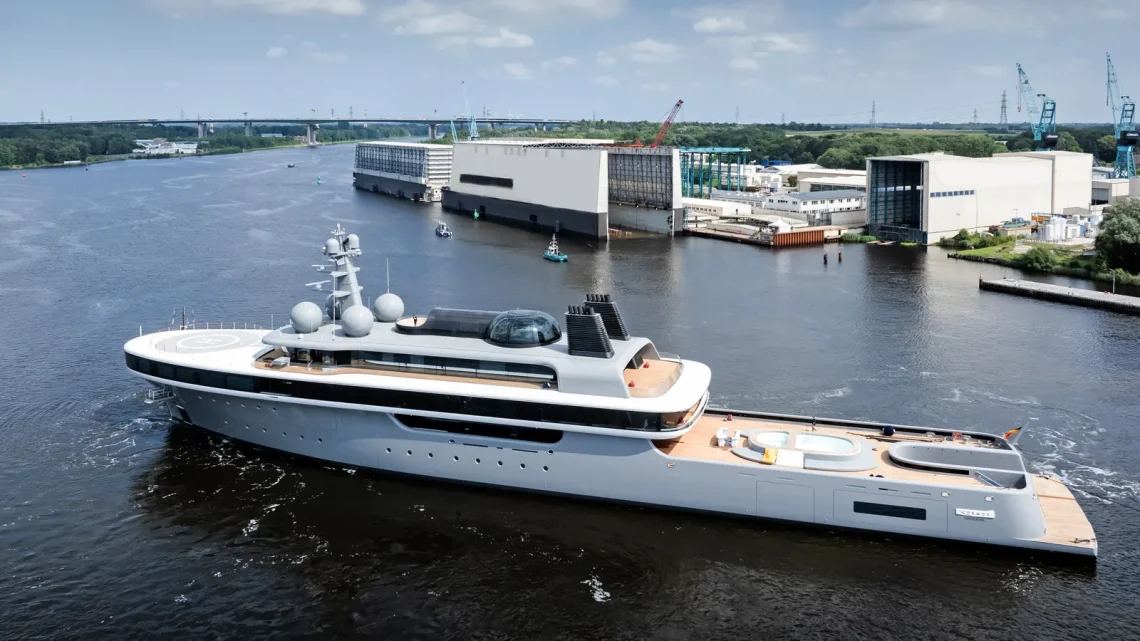
Lürssen’s 114.2m Project Cosmos Introduces Hydrogen Fuel Cells to Superyacht Design
August 11, 2025When German shipyard Lürssen rolled out Project Cosmos, it wasn’t just another sleek superyacht debut—it was a game-changer. Stretching 114.2 metres, this explorer-style beauty doesn’t just look the part; it’s packing an onboard methanol-to-hydrogen reformer that drives hydrogen fuel cells for hotel loads and even low-speed cruising. CEO Peter Lürssen didn’t mince words, calling Cosmos “an indelible project in the yard’s history.” With a résumé of 100 m+ vessels—like the 134.2 m Project Deep Blue delivered earlier this year—it’s clear they’re all about pushing boundaries. Due in 2026, Cosmos stands out as one of the first superyachts this size to blend next-gen fuel cell technology with Marc Newson’s signature glass design, Ice Class 1D certification, and explorer-grade features that slash noise and emissions in delicate environments.
Market Impact
The global superyacht scene—worth around $20 billion—has owners and regulators losing sleep over anyone still hooked on diesel. With the IMO shooting for a 40% greenhouse gas cut by 2030 and the EU’s Fit for 55 rules breathing down their necks, yards have to get creative or risk falling behind. By showcasing a methanol reformer that feeds a PEM fuel-cell stack, Lürssen ticks off both ECA (Emission Control Area) requirements and a growing craving for green credentials.
And get this—early adopters in the 100 m+ club could command a 5–10% premium on new builds, while methanol bunkering infrastructure gets a serious shot in the arm. Insurers and class societies keeping tabs on Cosmos’s safety systems might even tweak their risk assessments—and premiums—favoring more zero-emission technology projects.
Technical Snapshot
Methanol Reforming Unit: Think of it as a magic box—catalyst-driven to turn liquid methanol into hydrogen-rich syngas. That syngas then powers a PEM fuel-cell stack, kicking out mostly water and just a trace of CO₂. Translation: near-zero local emissions.
Hybrid Powertrain: A bespoke energy-management brain juggles power from the fuel cell, battery banks, and trusty diesel generators. The result is up to 30% fuel savings during hotel-mode and leisurely low-speed runs.
Safety & Storage: Double-walled methanol tanks, leak sensors, and dedicated ventilation channels make bunkering a breeze—and far safer than compressed hydrogen setups.
Advanced Glass Engineering: With Marc Newson’s thick, curved glass panels—a forward dome study plus continuous panoramic bands—Cosmos looks stunning and handles marine loads and thermal shifts like a champ.
Parallel Developments
Similar trials are popping up across the maritime world: mid-size yachts testing PEM units for auxiliary power, offshore service vessels evaluating methanol carriers, and class societies rolling out rulebooks for liquid-fuel reformers. Lürssen’s approach offers a scalable template for coastal ferries and patrol boats chasing zero-emission technology without sacrificing range.
Expert Viewpoint
Sure, the upfront cost of integrated reformers and fuel cells can be double that of conventional generators, but incentives and carbon regulations could shrink the payback to five years or so. “Project Cosmos will deliver crucial data on costs and reliability,” says a maritime energy consultant. Plus, early adopters might snag sweeter financing deals thanks to their green bona fides.
Key Takeaways
- Pioneer Scale: First 100 m+ superyacht with a full-scale methanol-to-hydrogen fuel cell system.
- Operational Gains: Whisper-quiet, emission-free hotel operations and low-speed cruising modes.
- Regulatory Fit: Aligns with IMO 2030 targets, ECA standards, and broader sustainable energy goals.
- Market Signal: Speeds up investment in methanol bunkering and liquid-fuel reformer adoption.
- Delivery: On track for 2026; live performance will steer future projects.
Strategic Implications
Project Cosmos doubles as a live lab for industrial decarbonization in luxury marine. It underscores how vital collaboration is—methanol suppliers, class societies, insurers, and regulators all need to sync up to refine safety protocols, build out infrastructure, and reset risk models. Over time, this blueprint could guide retrofits and new builds across offshore support, coastal logistics, and commercial shipping.
About Lürssen: Founded back in 1875 and based in Germany, Lürssen has a storied history in custom superyacht design, construction, and refits. From the beefy 134.2 m Project Deep Blue to a slew of 100 m+ masterpieces, they prove there’s no stopping demand for high-end, tech-forward vessels.
With hydrogen fuel cells finally making waves in superyacht design, Project Cosmos charts a new course for sustainable energy solutions at sea and cements a fresh benchmark for zero-emission technology on the water.



 With over 15 years of reporting hydrogen news, we are your premier source for the latest updates and insights in hydrogen and renewable energy.
With over 15 years of reporting hydrogen news, we are your premier source for the latest updates and insights in hydrogen and renewable energy.